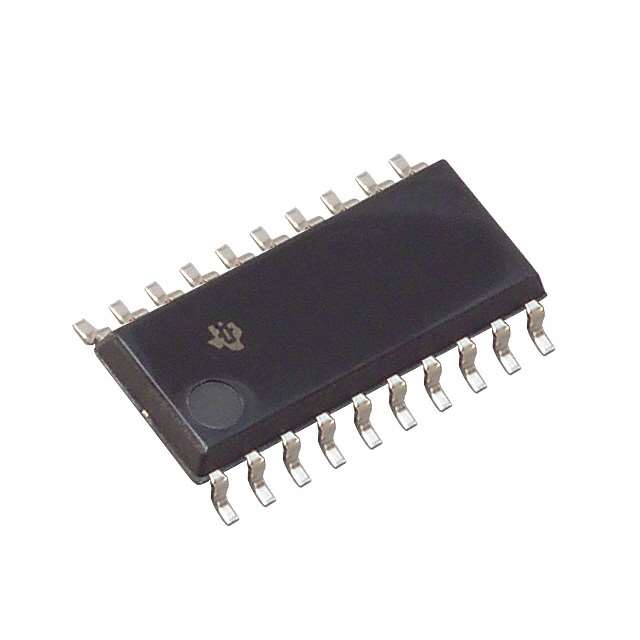SN74LV245ANSRG4
Product Overview
Category: Integrated Circuit (IC)
Use: The SN74LV245ANSRG4 is a high-speed octal bus transceiver designed for asynchronous communication between two buses. It allows bidirectional data transfer between the A and B buses, making it ideal for applications requiring data exchange between different systems.
Characteristics: - High-speed operation - Low power consumption - Wide voltage range (2 V to 5.5 V) - Schmitt-trigger inputs for noise immunity - 3-state outputs for bus isolation
Package: The SN74LV245ANSRG4 is available in a small-outline integrated circuit (SOIC) package. This package provides excellent thermal performance and ease of handling during assembly.
Essence: The essence of the SN74LV245ANSRG4 lies in its ability to facilitate seamless data transfer between two buses, enabling efficient communication between different systems.
Packaging/Quantity: The SN74LV245ANSRG4 is typically sold in reels containing 2500 units per reel.
Specifications
- Supply Voltage Range: 2 V to 5.5 V
- Input Voltage Range: 0 V to VCC
- Output Voltage Range: 0 V to VCC
- Operating Temperature Range: -40°C to +85°C
- Maximum Propagation Delay: 8 ns
- Maximum Operating Frequency: 125 MHz
Detailed Pin Configuration
The SN74LV245ANSRG4 has a total of 20 pins, which are assigned specific functions as follows:
- DIR (Direction Control Input)
- OE (Output Enable Input)
- A1 (Data Bus A, Bit 1)
- A2 (Data Bus A, Bit 2)
- A3 (Data Bus A, Bit 3)
- A4 (Data Bus A, Bit 4)
- A5 (Data Bus A, Bit 5)
- A6 (Data Bus A, Bit 6)
- A7 (Data Bus A, Bit 7)
- A8 (Data Bus A, Bit 8)
- GND (Ground)
- B8 (Data Bus B, Bit 8)
- B7 (Data Bus B, Bit 7)
- B6 (Data Bus B, Bit 6)
- B5 (Data Bus B, Bit 5)
- B4 (Data Bus B, Bit 4)
- B3 (Data Bus B, Bit 3)
- B2 (Data Bus B, Bit 2)
- B1 (Data Bus B, Bit 1)
- VCC (Supply Voltage)
Functional Features
- Bidirectional data transfer between two buses
- Direction control input for selecting data flow direction
- Output enable input for enabling/disabling the outputs
- Schmitt-trigger inputs for improved noise immunity
- 3-state outputs for bus isolation
Advantages and Disadvantages
Advantages: - High-speed operation allows for efficient data transfer - Low power consumption for energy-efficient applications - Wide voltage range enables compatibility with various systems - Schmitt-trigger inputs provide excellent noise immunity - 3-state outputs allow for bus isolation when needed
Disadvantages: - Limited to octal bus transceiver functionality - Not suitable for applications requiring more than eight data lines
Working Principles
The SN74LV245ANSRG4 operates based on the principles of digital logic. It uses internal circuitry to control the direction of data flow between the A and B buses. The DIR pin determines the direction, while the OE pin enables or disables the outputs. When enabled, the transceiver allows bidirectional data transfer between the buses. The Schmitt-trigger inputs ensure reliable signal reception, even in the presence of noise.
Detailed Application Field Plans
The SN74LV245ANSRG4 finds applications in various fields where data exchange between different systems is required. Some common application areas include:
- Industrial Automation: Used for communication between control systems and peripheral devices.
- Automotive Electronics: Facilitates data transfer between different automotive modules.
- Telecommunications: Enables data exchange between network equipment and communication devices.
- Consumer Electronics: Used in devices requiring data transfer between different subsystems.
- Medical Equipment: Allows communication between medical devices and control units.
Detailed and Complete Alternative Models
- SN74LVC245A: Similar functionality with improved voltage tolerance.
- SN74HCT245: Higher voltage handling capability but slower operation.
- SN74LVCH245A: Lower power consumption with comparable performance.
These alternative models offer similar functionality to the SN74LV245ANSRG4 but may have specific advantages or differences in operating characteristics that make them suitable for different applications.
*Note: This entry has
Lista 10 Vanliga frågor och svar relaterade till tillämpningen av SN74LV245ANSRG4 i tekniska lösningar
Sure! Here are 10 common questions and answers related to the application of SN74LV245ANSRG4 in technical solutions:
Q: What is the SN74LV245ANSRG4? A: The SN74LV245ANSRG4 is a non-inverting octal bus transceiver with 3-state outputs, commonly used for level shifting and signal buffering.
Q: What is the voltage range supported by SN74LV245ANSRG4? A: SN74LV245ANSRG4 supports a voltage range from 1.65V to 5.5V.
Q: How many channels does SN74LV245ANSRG4 have? A: SN74LV245ANSRG4 has 8 bidirectional channels.
Q: Can SN74LV245ANSRG4 handle high-speed data transmission? A: Yes, SN74LV245ANSRG4 can handle high-speed data transmission up to 100 MHz.
Q: What is the maximum current that SN74LV245ANSRG4 can source/sink? A: SN74LV245ANSRG4 can source/sink up to 32 mA per channel.
Q: Is SN74LV245ANSRG4 compatible with both CMOS and TTL logic levels? A: Yes, SN74LV245ANSRG4 is compatible with both CMOS and TTL logic levels.
Q: Can SN74LV245ANSRG4 be used for level shifting between different voltage domains? A: Yes, SN74LV245ANSRG4 can be used for level shifting between different voltage domains.
Q: Does SN74LV245ANSRG4 have built-in ESD protection? A: Yes, SN74LV245ANSRG4 has built-in ESD protection, making it more robust against electrostatic discharge.
Q: What is the power supply voltage range for SN74LV245ANSRG4? A: SN74LV245ANSRG4 operates with a power supply voltage range from 1.65V to 5.5V.
Q: Can SN74LV245ANSRG4 be used in both digital and analog applications? A: SN74LV245ANSRG4 is primarily designed for digital applications, but it can also be used in certain analog applications where appropriate.
Please note that these answers are general and may vary depending on specific application requirements.


